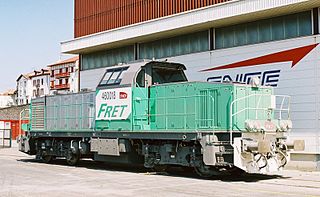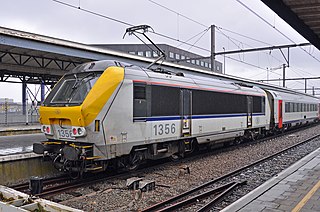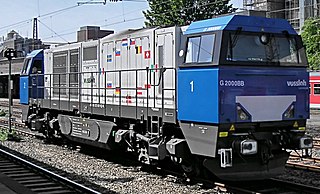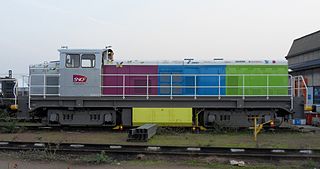
The SNCF Class BB 27300 is an electric locomotive. There are 67 BB 27300 locomotives, built as part of the Prima range by Alstom. The first BB 27300 were delivered starting in 2006. Painted in the blue and white livery of Transilien, the brand name for the SNCF network around Paris, these locomotives are the passenger equivalent of the freight-only SNCF Class BB 27000 and are equipped for push-pull operation on suburban passenger services in the Île-de-France region around Paris, working with refurbished VB2N double-deck carriages.

Bombardier TRAXX is a modular product platform of mainline diesel-electric and electric locomotives produced by Bombardier Transportation, which was built in both freight and passenger variants. The first version was a dual-voltage AC locomotive built for German railways from the year 2000. Later types included DC versions, as well as quadruple-voltage machines, able to operate on most European electrification schemes: 1.5/3.0 kV DC and 15/25 kV AC. The family was expanded in 2006 to include diesel-powered versions. Elements common to all variants include steel bodyshells, two bogies with two powered axles each, three-phase asynchronous induction motors, cooling exhausts on the roof edges, and wheel disc brakes.

The Indian locomotive class WAM-4 is a class of 25 kV AC electric locomotives that was developed in the 1970 by Chittaranjan Locomotive Works for Indian Railways. The model name stands for broad gauge (W), alternating current (A), mixed traffic (M) engine, 4th generation (4). They entered service in March 1971. A total of 500 WAM-4 were built at CLW between 1970 and 1983, which made them the most numerous class of mainline electric locomotive till its successor the WAG-5.
A hybrid train is a locomotive, railcar or train that uses an onboard rechargeable energy storage system (RESS), placed between the power source and the traction transmission system connected to the wheels. Since most diesel locomotives are diesel-electric, they have all the components of a series hybrid transmission except the storage battery, making this a relatively simple prospect.

The SNCF class BB 60000 are a class of 4 axle heavy shunting and light freight diesel electric locomotives built at the Vossloh Espana works in Valencia. Since the class is primarily used as a freight locomotive the class is commonly referred to as SNCF BB460000.

The Class 13 are a type of mixed use 200 km/h (124 mph) multivoltage electric locomotive of type Traxis designed by Alstom in the late 1990s for the Belgian and Luxembourgish railways.

The SNCF Class BB 36000 locomotives are a class of triple voltage 4 axle twin bogie electric locomotives built by GEC-Alsthom between 1996 and 2001 for SNCF.

The Voith Maxima locomotives are a family of diesel-hydraulic locomotives built by Voith Turbo Lokomotivtechnik GmbH & Co. KG., a subsidiary of Voith. The most powerful single-engined diesel-hydraulic locomotive in the world, the Maxima 40CC is rated at 3,600 kW. Initially two versions of a 6 axle C'C' machine were offered with medium speed engines from the Anglo-Belgian Corporation; the Maxima 30CC and Maxima 40CC. In 2008 a third model, the Maxima 20BB, a 4 axle B'B' machine was added to the range.

The Voith Gravita locomotives are a family of road switcher diesel-hydraulic locomotives built by Voith Turbo Lokomotivtechnik GmbH & Co. KG.. Available in a range of configurations from 4 to 6 axles, they are designed for shunting and light and medium freight operations.

Gmeinder GmbH was a German locomotive and engineering company based in Mosbach. Its products included diesel engines, small locomotives (shunters) and other railway locomotive parts. Much of its business came through the German railways, though it also exported to the rest of Europe and the rest of the world.

The Prima Diesel-electric locomotives are a class of medium and heavy, four- and six-axle, passenger and freight mainline locomotives. They have been built both to 1,435 mm standard and 1,668 mm broad gauges, and find use in the Middle East, Europe and North America. Alstom is the primary designer in cooperation with both General Motors and Siemens.

The SNCF BB 75000 are 4 axle, Bo′Bo′, diesel electric locomotives ordered in 2000 by SNCF for freight operations to renew its aging fleet.

The Eurorunner family of locomotives are a series of medium- to high-power diesel-electric locomotives built by Siemens for the European market. Introduced from 2002 onwards, they share design characteristics with the successful Eurosprinter range of electric locomotives, also built by Siemens.

The G 2000 BB is a four axle heavy shunting and mainline locomotive, designed by German company Vossloh and built at the former MaK plant in Kiel. At the time of its introduction in 2000 it was the most powerful hydraulic transmission locomotive in Vossloh's range.

The Vossloh G1206 is a B'B' diesel hydraulic freight locomotive built in Kiel and used by several European railway operators including a SNCF specific variant the BB 461000 series.

The AD43C is a type of mainline 6 axle Co'Co' diesel locomotive designed by Alstom and used by the Islamic Republic of Iran Railways (RAI). It was in production from 2000. Delivery started in 2002.

The Vossloh G6 is a C diesel-hydraulic shunting locomotive, and the first locomotive of Vossloh's fifth generation programme. The G6 is the successor of the MaK/Vossloh G765, a third-generation MaK locomotive still offered in the 2000s.

BB 63413 PLATHEE is a hybrid locomotive that was used for testing on the French rail operator SNCF. PLATHEE is an acronym for "Platform for Energy- Efficient and Environmentally Friendly Hybrid Trains".

The Indian locomotive class WAG-12B is a class of 25 kV AC electric locomotives that was developed in 2017 by Alstom with technological collaboration with Indian Railways. The model name stands for broad gauge (W), Alternating Current (AC), Goods traffic (G) locomotive, 12000hp (12). They entered trial service in 2019. A total of 163 WAG-12B have been built at Electric Locomotive Factory, Madhepura, Bihar, India.

The SNCF Class BB 66000 is a class of 318 centre cab diesel locomotives built for SNCF by a consortium of CAFL, CEM, Alsthom, Fives-Lille and SACM between 1960 and 1968.






















